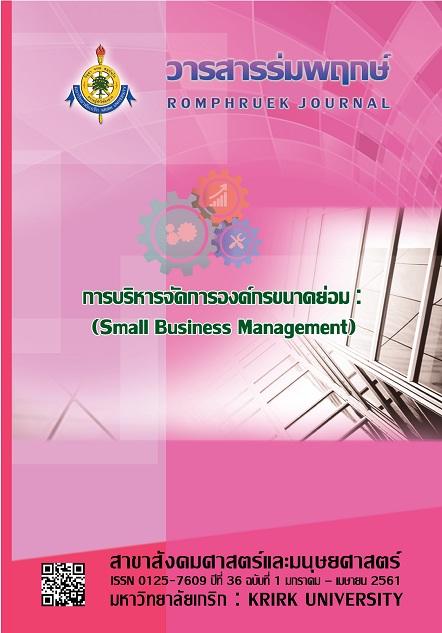Leadership of Modern Organization
Main Article Content
Abstract
The advancement of modern technology resulted in the rapid flow of information and more complex environment. The organization, therefore, needed to adjust and develop their personnel to have leadership competencies, diversify and be flexible to sustain the organizational effectiveness. The leadership theories consist of five groups, these are Trait Leadership Theories; Behavioral Leadership Theories; Interactive Leadership Theories; Situational Leadership Theories; and Inspirational-Motivation Leadership Theories. Each theory has both distinctive and weak points. As a result, the leadership theories have been changed and developed as time passed by. The majority of the leadership theories emphasized more on the leadership of the leaders than on the leadership of the organization. Leadership factors influence toward the organizational effectiveness. The organization with lots of personnel possessed with leadership competencies would increase the organizational effectiveness.
Article Details
Every article published in the Romphruek Journal of the Humanities and Social Sciences is the opinion and point of view of the authors. Thery're not the viewpoint of Krirk University or the editored department. Any part or all of the articles for pablication must be clearly cited.
References
พิชาย รัตนดิลก ณ ภูเก็ต. (2553). องค์การและการบริหารจัดการ. กรุงเทพฯ : ธิงค์ บียอนด์ บุ๊คส์.
อุษณีย์ มงคลพิทักษ์สุข. (2556). ภาวะผู้นำเต็มขอบเขตของปลัด อบต. กับประสิทธิผลขององค์การ :
การวิเคราะห์จำแนกพหุ. ร่มพฤกษ์, 31(2), 19-48.
Ash, R. C. and Persall, J. M. (2007). The Principal as Chief Learning Officer. National
Association of Secondary School Principal 7(84), 15-22.
Barnes, L. B. and Kriger, M. P. (1986). The Hidden Side of Organizational Leadership.
Sloan Management Review. 28(1), 15-25.
Bass, B. M. (1985). Leadership and Performance Beyond Expectations. New York : Free Press.
Belasco, J. A. and Stayer, R. C. (1993). Flight of the Buffalo: Soaring to Excellence, Learning
to Let Employees Lead. New York : Warner Books, Inc.
Burns, J. M. (1978). Leadership. New York : Harper and Row.
Bjugstad, K., Thach, E. C., Thompson, K. J. & Morris, A. (2006). A Fresh Look at Followership :
A Model for Matching Followership and Leadership Styles. Journal of Behavioral and
Applied Management, 7(3), 304-319.
Chaleff, I. (2003). The Courageous Follower. San Francisco : Berret - Koehler.
Daft, R. L. (2001). The Leadership Experience. Orlando : Harcourt College.
Fullan, M. F. (2003). The Moral Imperative of School Leadership. California : Corwin Press.
Glickman, C., Gordon, S. and Ross-Gordon, J. (2001). Supervision and Instructional
Leadership: A Developmental Approach (5th ed.). Needham Heights, MA : Allyn and
Bacon.
Hatch, W. F. (2010). Asia's Flying Geese: How Regionalization Shapes Japan. Ithaca : Cornell
University Press.
Hersey, P., Blanchard, K. H. and Johnson, D. E. (2001). Management of Organizational
Behavior: Leading Human Resources (8th ed.). Upper Saddle River, NJ : Prentice Hall.
Marion, R. and Uhl-Bien, M. (2001). Leadership in Complex Organizations. The Leadership
Quarterly, 12 (4), 389-418.
Northouse, P. G. (2012). Introduction to leadership : Concepts and Practice. Thousand Oaks,
CA : Sage.
Oslon, m. (1991). Lessons from Geese. (18 January 2018) Retrived from http://ucanr.edu/sites/
SFIT/files/191209.pdf.
Richardson, R. J. and Thayer, S. K. (1993). The Charisma Factor : How to Develop Your Natural
Leadership Ability. Upper Saddle River, NJ : Prentice Hall.
Robbins, S. P. (2005). Organizational Behavior. Upper Saddle River, NJ : Pearson.
Stoner, A. F., Freeman, R. E. and Gilbert, D. R. (1996). Management. New Delhi : Prentice Hall of India.
Wheatley, M. J. (1999). Leadership and The New Science : Discovering Order in a Chaotic World.
San Francisco : Berrett-Koehler.


